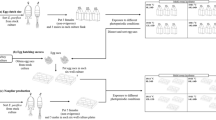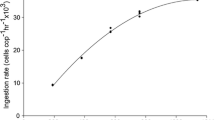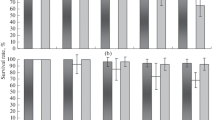Abstract
The effects of salinity on the copepod, Acartia tonsa in terms of daily egg production rate (EPR), hatching success, fecal pellet production rate (FPR), naupliar development time and survival, sex ratio, and total life span were determined in laboratory conditions through three experiments. In experiment 1, EPR, hatching success, and FPR of individual females were monitored at salinities of 13, 20, 35 and 45 during short-periods (seven consecutive days). Results show EPR was affected by salinity with the highest outputs recorded at 20 and 35, respectively, which were considerably higher than those at 13 and 45. Mean FPR was also higher in 35 and 20. In experiment 2, the same parameters were evaluated over total life span of females (long-term study). The best EPR and FPR were observed in 35, which was statistically higher than at 13 and 20. In experiment 3, survival rates of early nauplii until adult stage were lowest at a salinity of 13. The development time increased with increasing of salinity. Female percentage clearly decreased with increasing salinity. Higher female percentages (56.7% and 52.2%, respectively) were significantly observed at two salinities of 13 and 20 compared to that at 35 (25%). Total longevity of females was not affected by salinity increment. Based on our results, for mass culture we recommend that a salinity of 35 be adopted due to higher reproductive performances, better feeding, and faster development of A. tonsa.
Similar content being viewed by others

References
Bagheri S, Sabkara J, Mirzajani A, Khodaparast S H, Yosefzad E, Yeok F S. 2013. List of zooplankton taxa in the Caspian Sea waters of Iran. J. Mar. Biol., 2013: 134263.
Calliari D, Andersen C M, Thor P, Gorokhova E, Tiselius P. 2006. Salinity modulates the energy balance and reproductive success of co-occurring copepods Acartia tonsa and A. clausi in different ways. Mar. Ecol. Prog. Ser., 312: 177–188.
Camus T, Zeng C S. 2008. Effects of photoperiod on egg production and hatching success, naupliar and copepodite development, adult sex ratio and life expectancy of the tropical calanoid copepod Acartia sinjiensis. Aquaculture, 280 (1-4): 220–226.
Camus T, Zeng C S. 2009. The effects of stocking density on egg production and hatching success, cannibalism rate, sex ratio and population growth of the tropical calanoid copepod Acartia sinjiensis. Aquaculture, 287 (1-2): 145–151.
Carlotti F, Rey C, Javanshir A, Nival S. 1997. Laboratory studies on egg and faecal pellet production of Centropages typicus: effect of age, effect of temperature, individual variability. J. Plankton Res., 19 (8): 1143–1165.
Castro-Longoria E. 2003. Egg production and hatching success of four Acartia species under different temperature and salinity regimes. J. Crustacean Biol., 23(2): 289–299.
Cervetto G, Gaudy R, Pagano M. 1999. Influence of salinity on the distribution of Acartia tonsa (Copepoda, Calanoida). J. Exp. Mar. Biol. Ecol., 239 (1): 33–45.
Chen Q X, Sheng J Q, Lin Q, Gao Y L, Lv J Y. 2006. Effect of salinity on reproduction and survival of the copepod Pseudodiaptomus annandalei Sewell, 1919. Aquaculture, 258 (1-4): 575–582.
Chinnery F E, Williams J A. 2004. The influence of temperature and salinity on Acartia (Copepoda: Calanoida) nauplii survival. Mar. Biol., 145 (4): 733–738.
Devreker D, Pierson J J, Souissi S, Kimmel D G, Roman M R. 2012. An experimental approach to estimate egg production and development rate of the calanoid copepod Eurytemora affinis in Chesapeake Bay, USA. J. Exp. Mar. Biol. Ecol., 416-417: 72–83.
Devreker D, Souissi S, Winkler G, Forget-Leray J, Leboulenger F. 2009. Effects of salinity, temperature and individual variability on the reproduction of Eurytemora affinis (Copepoda; Calanoida) from the Seine estuary: a laboratory study. J. Exp. Mar. Biol. Ecol., 368 (2): 113–123.
Drillet G, Frouël S, Sichlau M H, Jepsen P M, Højgaard J K, Joarder A K, Hansen B W. 2011. Status and recommendations on marine copepod cultivation for use as live feed. Aquaculture, 315 (3-4): 155–166.
Gaudy R, Verriopoulos G. 2004. Spatial and seasonal variations in size, body volume and body proportion (prosome: urosome ratio) of the copepod Acartia tonsa in the semiclosed ecosystem (Berre lagoon, Western Mediterranean). Hydrobiologia, 513 (1): 219–231.
Guillard R R L. 1975. Culture of phytoplankton for feeding marine invertebrates. In: Smith W L, Chanley M H eds. Culture of Marine Invertebrate Animals. Plenum Press, New York, USA. p.26–60.
Gusãmo L F M, McKinnon A D. 2009. Sex ratios, intersexuality and sex change in copepods. J. Plankton Res., 31 (9): 1101–1117.
Hagiwara A, Lee C S, Shiraishi D J. 1995. Some reproductive characteristics of the broods of the harpacticoid copepod Tigriopus japonicus cultured in different salinities. Fish. Sci., 61 (4): 618–622.
Hirst A G, McKinnon A D. 2001. Does egg production represent adult female copepod growth? A call to account for body weight changes. Mar. Ecol. Prog. Ser., 223: 179–199.
Holste L, Peck M A. 2006. The effects of temperature and salinity on egg production and hatching success of Baltic Acartia tonsa (Copepoda: Calanoida): a laboratory investigation. Mar. Biol., 148 (5): 1061–1070.
Irigoien X, Obermuller B, Head R N, Harris R P, Rey C, Hansen B W, Hygum B H, Heath M R, Durbin E G. 2000. The effect of food on the determination of sex ratio in Calanus spp.: evidence from experimental studies and field data. ICES J. Mar. Sci., 57 (6): 1752–1763.
Iwasaki H, Katoh H, Fujiyama T. 1977. Cultivation of marine copepod, Acartia clausi Giesbrecht. I. Factors affecting the generation time and egg production. Bull. Plankton Soc. Japan, 24 (1): 55–61.
Johnson J K. 1974. The dynamics of an isolated population of Acartia tonsa dana (Copepoda) in Yaquina Bay, Oregon. Oregon State University, Corvallis, Oregon, USA. 97p.
Katona S K. 1970. Growth characteristics of the copepods Eurytemora affinis and E. herdmani in laboratory cultures. Helg. wiss. Meeresunters., 20 (1): 373–384.
Kimoto K, Uye S I, Takashi O. 1986. Egg production of a brackish-water calanoid copepod Sinocalanus tenellus in relation to food abundance and temperature. Bull. Plankton Soc. Japan, 33 (2): 133–146.
Klein Breteler W C M, Fransz H G, Gonzalez S R. 1982. Growth and development of four calanoid copepod species under experimental and natural conditions. Netherlands. J. Sea. Res., 16: 195–207.
Lance J. 1965. Respiration and osmotic behaviour of the copepod Acartia tonsa in diluted sea water. Comp. Biochem. Phys., 14 (1): 155–165.
Matias-Peralta H, Yusoff F M, Shariff M, Arshad A. 2005. Effects of some environmental parameters on the reproduction and development of a tropical marine harpacticoid copepod Nitocra affinis f. californica Lang. Mar. Pollut. Bull., 51 (8-12): 722–728.
Mauchline J. 1998. The biology of calanoid copepods. Adv. Mar. Biol., 33: 1–13.
McKinnon A D, Duggan S, Nichol P D, Rimmer M A, Semmens G, Robino B. 2003. The potential of tropical paracalanid copepods as live feeds in aquaculture. Aquaculture, 223 (1-4): 89–106.
Milione M, Zeng C S. 2008. The effects of temperature and salinity on population growth and egg hatching success of the tropical calanoid copepod, Acartia sinjiensis. Aquaculture, 275 (1-4): 116–123.
Miliou H. 1993. Temperature, salinity and light induced variations on larval survival and sex ratio of Tisbe holothuriae Humes (Copepods: harpacticoida). J. Exp. Mar. Biol. Ecol., 173 (1): 95–109.
Ogle J. 1979. Adaptation of a brown water culture technique to the mass culture of the copepod Acartia tonsa. Gulf Res. Rep., 6 (3): 291–292.
Ohs C L, Rhyne A L, Grabe S W, DiMaggio M A, Stenn E. 2010. Effects of salinity on reproduction and survival of the calanoid copepod Pseudodiaptomus pelagicus. Aquaculture, 307 (1-2): 219–224.
Peck M A, Holste L. 2006. Effects of salinity, photoperiod and adult stocking density on egg production and egg hatching success in Acartia tonsa (Calanoida: copepoda): optimizing intensive cultures. Aquaculture, 255 (1-4): 341–350.
Péqueux A. 1995. Osmotic regulation in crustaceans. J. Crustacean Biol., 15 (1): 1–60.
Rey J R, Kain T, Crossman R A, Peterson M, Shaffer J, Vose F. 1991. Zooplankton of impounded marshes and shallow areas of a subtropical lagoon. Florida., Scientists, 54 (3-4): 191–203.
Rodriguez-Graoa L, Calliari D, Tiselius P, Hansen B W, Sköld H N. 2010. Gender-specific ageing and non-Mendelian inheritance of oxidative damage in marine copepods. Mar. Ecol. Prog. Ser., 401: 1–13.
Rokneddine A. 2005. The influence of salinity and temperature on the growth of Arctodiaptomus salinus (DADAY, 1885) (Copepoda, Calanoida), from the temporary salt marsh, La Sebkha Zima, Morocco. Crustaceana, 77 (9): 1025–1044.
Sokal R R, Rohlf F J. 1981. Biometry. 2 nd edn. W. H. Freeman and Company, New York, USA. 776p.
Sørensen T F, Drillet G, Engell-Sørensen K, Hansen B W, Ramløv H. 2007. Production and biochemical composition of eggs from neritic calanoid copepods reared in large outdoor tanks (Limfjord, Denmark). Aquaculture, 263 (1-4): 84–96.
Støttrup J G, McEvoy L A. 2003. Live Feeds in Marine Aquaculture. Blackwell Science Ltd, Oxford, UK. 337p.
Stottrup J G, Richardson K, Kirkegaard E, Pihl N J. 1986. The cultivation of Acartia tonsa Dana for use as a live food source for marine fish larvae. Aquaculture, 52 (2): 87–96.
Trujillo-Ortiz A. 1990. Hatching success, egg production and development time of Acartia californiensis Trinast (Copepoda: calanoida) under laboratory conditions. Cienc. Mar., 16 (1): l–22.
Author information
Authors and Affiliations
Corresponding author
Additional information
Supported by the SANRU University
Rights and permissions
About this article
Cite this article
Shayegan, M., Esmaeili Fereidouni, A., Agh, N. et al. Effects of salinity on egg and fecal pellet production, development and survival, adult sex ratio and total life span in the calanoid copepod, Acartia tonsa: a laboratory study. Chin. J. Ocean. Limnol. 34, 709–718 (2016). https://doi.org/10.1007/s00343-016-5030-4
Received:
Accepted:
Published:
Issue Date:
DOI: https://doi.org/10.1007/s00343-016-5030-4



